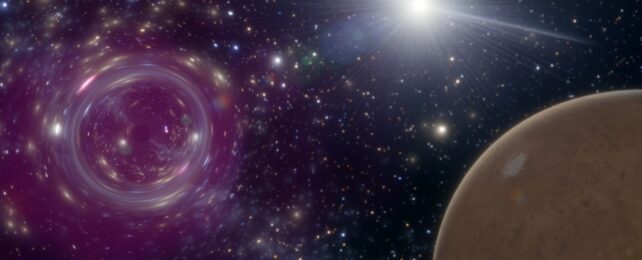Tiny, ancient black holes could whizz through our Solar System as often as once a decade, according to a new study. We could spot them by watching for a wobble in the orbit of Mars – and that could help uncover dark matter.
Primordial black holes (PBHs) are hypothetical objects that may have been born in the first second after the Big Bang, from dense pockets of ionized matter collapsing. Over the last 13.8 billion years they would have scattered across the cosmos.
If invisible masses pervading the universe that are only felt through gravity sound familiar, well, that's no coincidence: PBHs are a leading candidate for dark matter.
Now, a team of physicists in the US has calculated how often they might swing through our neck of the woods, based on the estimated distribution of dark matter across a given region of space.
They found that a primordial black hole, packing the mass of an asteroid into a space the size of a single atom, should stream through the inner Solar System about once every 10 years or so.
Although we wouldn't be able to directly see it, such a visitor would still make its presence known. The team found that if a PBH came within about 450 million kilometers (280 million miles) of Mars, it would trigger a detectable wobble in the red planet's orbit.
The shift would only be about 1 meter (3.3 feet) over 10 years, but that's enough for sensors to pick up, since we can measure the distance of Mars from Earth to within about 10 centimeters (4 inches).
The study started with a fun hypothetical question: what would happen if a PBH zipped past a person? Lead author, astrophysicist Tung Tran from Massachusetts Institute of Technology (MIT), roughly calculated that if one came within a meter of you, you'd be flung about 6 meters away in 1 second.
While that scenario is extremely unlikely, it got the team wondering how a PBH flying through the solar system would affect planets and moons.
"We extrapolated to see what would happen if a black hole flew by Earth and caused the Moon to wobble by a little bit," says Tung.
"The numbers we got were not very clear. There are many other dynamics in the solar system that could act as some sort of friction to cause the wobble to dampen out."
So, the researchers then simulated the effects of a PBH flyby on Mercury, Venus, and Mars to see if their wobbles would be easier to spot. Of those, Mars gave the clearest signal, largely because it's such a heavily monitored planet.
The obvious question that raises is – if a PBH with only the mass of an asteroid can do this, wouldn't every space rock that swings past exert the same influence? The answer is yes, kinda. But the effect would look different.
Asteroids are relatively slow-moving and tend to stick to the same disk around the Sun as the planets, so their interactions happen on longer timescales. But a PBH zips through the Solar System, from any direction, at up to 200 kilometers per second. Their speedy interactions stand out as a single point in time.
Still, more detailed simulations involving more objects will need to be conducted to get a more precise understanding of those dynamics.
"We need as much clarity as we can of the expected backgrounds, such as the typical speeds and distributions of boring space rocks, versus these primordial black holes," says MIT physicist David Kaiser.
"Luckily for us, astronomers have been tracking ordinary space rocks for decades as they have flown through our Solar System, so we could calculate typical properties of their trajectories and begin to compare them with the very different types of paths and speeds that primordial black holes should follow."
Of course, we don't even know for sure that primordial black holes exist. But with a bit more work, it's possible that astronomers could get lucky, spot a Martian wobble, and unravel one of the biggest cosmological mysteries.
The research was published in the journal Physical Review D.
